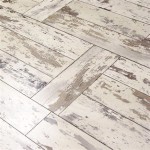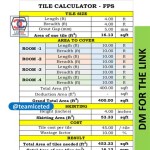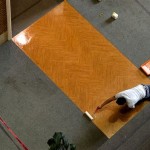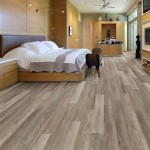Vinyl Flooring Design for Living Rooms: A Comprehensive Guide
Vinyl flooring has emerged as a popular choice for living rooms due to its versatility, durability, and cost-effectiveness. Modern manufacturing processes have transformed vinyl from a basic, utilitarian material to a sophisticated flooring option that mimics the look of hardwood, tile, and stone with remarkable accuracy. This article explores the various aspects of vinyl flooring design for living rooms, providing a comprehensive overview of types, styles, installation, and maintenance considerations.
Understanding the Types of Vinyl Flooring
The term "vinyl flooring" encompasses several different types of products, each with its own unique characteristics and suitability for different applications. Understanding these distinctions is crucial for selecting the ideal option for a living room.
Sheet Vinyl: Sheet vinyl flooring is sold in large rolls, typically six or twelve feet wide. This allows for seamless installation in most living rooms, minimizing the number of visible seams. Sheet vinyl is often the most budget-friendly option and is available in a wide range of designs and patterns. It consists of multiple layers, including a printed design layer, a wear layer, and a backing layer. The thickness of the wear layer is a key indicator of the flooring's durability and resistance to scratches and scuffs. High-quality sheet vinyl can effectively replicate the look of tile or wood, offering a cost-effective alternative to more expensive materials.
Vinyl Tile: Vinyl tile flooring is sold in individual tiles, typically in square or rectangular shapes. This format allows for greater design flexibility, as different colors and patterns can be combined to create custom installations. Vinyl tiles are available in various thicknesses and constructions, including solid vinyl tiles and composite vinyl tiles.
Luxury Vinyl Tile (LVT): LVT is a premium type of vinyl flooring designed to closely mimic the appearance of natural materials such as wood, stone, and ceramic tile. It features a thicker construction than standard vinyl tile and often incorporates embossed textures that further enhance its realism. LVT is known for its durability, water resistance, and ease of maintenance. It is a popular choice for high-traffic areas and spaces where moisture is a concern. LVT is often installed using a click-lock system, which simplifies the installation process and eliminates the need for adhesives.
Luxury Vinyl Plank (LVP): LVP is similar to LVT, but it is manufactured in plank form to replicate the look of hardwood flooring. LVP planks are available in various lengths and widths, allowing for realistic wood-look installations. Like LVT, LVP features a durable wear layer and is resistant to scratches, stains, and water damage. The click-lock installation system makes LVP a popular choice for DIY projects. It provides a warm, comfortable feel underfoot, making it a suitable option for living rooms.
Considerations for Vinyl Flooring Design in Living Rooms
Selecting the right vinyl flooring for a living room involves considering various factors, including design aesthetics, durability requirements, budget constraints, and installation considerations. Careful planning and research are essential to achieving the desired look and performance.
Aesthetic Preferences: The aesthetic of the vinyl flooring should complement the overall design of the living room. Consider the existing furniture, wall color, and architectural style when choosing a design. Wood-look vinyl plank flooring can add warmth and character to a living room, while stone-look vinyl tile can create a sophisticated and modern ambiance. For a more traditional look, consider patterned sheet vinyl flooring with intricate designs. The color of the flooring can also significantly impact the overall feel of the room. Lighter colors can make a small room feel larger and brighter, while darker colors can create a more intimate and cozy atmosphere.
Durability and Traffic: The durability of the vinyl flooring should be appropriate for the amount of traffic the living room receives. In high-traffic areas, such as entryways and walkways, it is important to choose a vinyl flooring with a thick wear layer. LVT and LVP typically offer superior durability compared to standard sheet vinyl or vinyl tile. Consider the presence of pets and children when selecting a flooring option. Vinyl flooring is generally resistant to scratches and stains, but it is important to choose a product that is specifically designed to withstand the wear and tear of everyday life.
Budget: Vinyl flooring is available at a wide range of price points, depending on the type, quality, and design. Sheet vinyl is generally the most affordable option, while LVT and LVP are typically more expensive. It is important to establish a budget before starting the selection process and to consider the long-term cost of ownership. While a cheaper flooring option may save money upfront, it may require more frequent replacement, leading to higher costs in the long run.
Installation: The installation method for vinyl flooring varies depending on the type of product. Sheet vinyl typically requires professional installation to ensure a seamless and properly adhered surface. Vinyl tile and LVT/LVP can often be installed as a DIY project, particularly if using a click-lock system. However, proper subfloor preparation is essential for a successful installation. The subfloor must be level, clean, and dry before installing any type of vinyl flooring. Uneven subfloors can lead to uneven flooring and potential damage over time. Consider the cost of professional installation when budgeting for a vinyl flooring project.
Underlayment: While some vinyl flooring options come with an attached underlayment, others may require a separate underlayment to be installed. Underlayment provides cushioning, sound insulation, and moisture protection. It can also help to level out minor imperfections in the subfloor. When selecting an underlayment, consider the recommendations of the flooring manufacturer. Using the wrong type of underlayment can void the warranty or compromise the performance of the flooring.
Design Ideas and Considerations for Living Room Vinyl Flooring
Beyond the technical aspects of choosing vinyl flooring, the design possibilities are vast. Consider these ideas to enhance the visual appeal of your living room.
Wood-Look Planks in Herringbone Pattern: Arrange LVP in a classic herringbone pattern for a sophisticated and timeless look. This adds visual interest and elevates the overall design. Consider using wider planks for a more modern and spacious feel.
Stone-Look Tiles with Grout Lines: Choose LVT that mimics the appearance of natural stone, such as slate or travertine. Use grout lines to create a more realistic tile appearance. Opt for a contrasting grout color to highlight the tile pattern and add depth.
Area Rugs for Added Comfort and Style: Enhance vinyl flooring with strategically placed area rugs. Rugs can add warmth, texture, and color to the living room. They can also define different zones within the space, such as a seating area or a play area. Choose rugs with non-slip backing to prevent them from sliding on the vinyl flooring.
Accent Walls with Coordinating Colors: Coordinate the color of the vinyl flooring with an accent wall to create a cohesive and visually appealing design. For example, if you choose a wood-look vinyl plank flooring with warm tones, consider painting an accent wall in a complementary shade of beige or brown.
Custom Borders and Inlays: Create a unique and personalized look by adding custom borders and inlays to the vinyl flooring. This can be achieved by using different colors or patterns of vinyl tile or by incorporating metallic or decorative accents. Custom designs can add a touch of elegance and sophistication to the living room.
Consider the Lighting: Natural and artificial lighting can significantly impact the appearance of vinyl flooring. Consider how the light will reflect off the flooring and choose a color and finish that complements the lighting conditions in the living room. Lighter colors can brighten up a dark room, while darker colors can create a more dramatic effect.
Maintenance and Care: Proper maintenance is essential for preserving the appearance and longevity of vinyl flooring. Regularly sweep or vacuum the floor to remove dirt and debris. Use a damp mop with a mild detergent to clean the floor as needed. Avoid using harsh chemicals or abrasive cleaners, as they can damage the surface of the vinyl. Protect the flooring from scratches by using furniture leg protectors and avoiding dragging heavy objects across the floor. With proper care, vinyl flooring can provide years of beauty and performance in your living room.

Choosing Vinyl Flooring For Your Living Room Tarkett

Types Of Vinyl Flooring The Home Depot

Living Room Sheet Vinyl Flooring Leoline

Ways To Style Vinyl Flooring Patterns Lx Hausys
Everything You Need To Know About Vinyl Flooring Tarkett

Living Room Lvt Flooring Tiles Harvey Maria

Living Room Flooring Ideas And Trends Twenty Oak

Lifeproof Ashen Grove Marble 11 9 X23 8 Tile Flooring Si69413l

Exploring Vinyl Flooring Trends For 2024 America

Everything You Need To Know About Luxury Vinyl Planks
Related Posts








